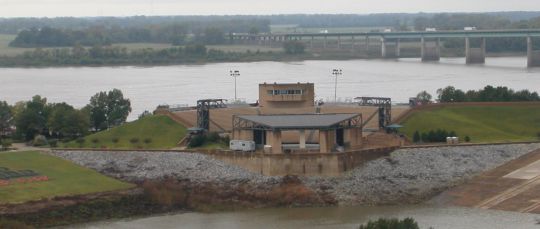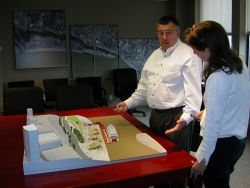 After arriving in Memphis, Tenn., birthplace of rock ‘n’ roll, Katharine and I headed straight out to Mud Island for a Smashing Pumpkins concert. (Work related, I swear!) The concert was held at the Mud Island Amphitheater, an open-air venue on the long, narrow peninsula created to shelter a small harbor and keep a meandering tributary on course.
After arriving in Memphis, Tenn., birthplace of rock ‘n’ roll, Katharine and I headed straight out to Mud Island for a Smashing Pumpkins concert. (Work related, I swear!) The concert was held at the Mud Island Amphitheater, an open-air venue on the long, narrow peninsula created to shelter a small harbor and keep a meandering tributary on course.
While the Pumpkins performed, my attention was focused on the river flowing just behind them. Even in the cold wind and drizzle, the outdoor arena was a great place to reflect and really connect with the river. But then I began to wonder how people interact with the river when they’re not watching Billy Corgan rock aquamarine manpris and stripey knee-highs.

This morning, we headed out to meet with John Conroy of the Memphis Riverfront Development Corporation, the group that manages Mud Island Park and is working to develop a number of areas in downtown Memphis. Conroy showed us aerial maps of the city as well as drawings and a 3D model of RDC’s plans for a major project on the riverfront that includes floating docks to accommodate the changing water levels and a mixed-use promenade that would include stores, restaurants, and residential areas.
 The projects RDC is working on aren’t embraced by everyone here. While we heard a number of people complain about the lack of restaurants along the riverfront ("you can’t even get a Coke!"), there are others who would rather see the area turned into parkland. Yet another complicating factor is the historical significance of many of the buildings downtown (some of which would be torn down in RDC’s plan) as well as the cobblestones that pave the riverbank.
The projects RDC is working on aren’t embraced by everyone here. While we heard a number of people complain about the lack of restaurants along the riverfront ("you can’t even get a Coke!"), there are others who would rather see the area turned into parkland. Yet another complicating factor is the historical significance of many of the buildings downtown (some of which would be torn down in RDC’s plan) as well as the cobblestones that pave the riverbank.
It’s a complex issue, and I certainly don’t have an answer. What’s been interesting in seeing these three cities is that each one faces different challenges in terms of what the Mississippi is like in their particular neck of the woods (fast-moving, heavy flooding, migrating) and yet many of them are facing similar questions about what is the right balance between creating economic opportunities through development projects and maintaining a wealth of green space and natural habitat.
Of the three cities we’ve seen, Memphis is the least far-along in plans to revitalize riverfront and downtown areas. It will be interesting to watch how it shakes out and perhaps plan another trip to see it all in action … meanwhile, for the near future, stay tuned for more on the developing controversy in Memphis.

